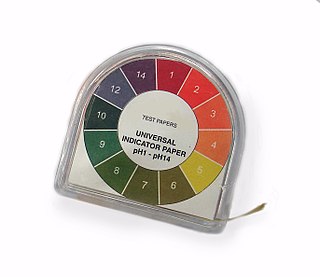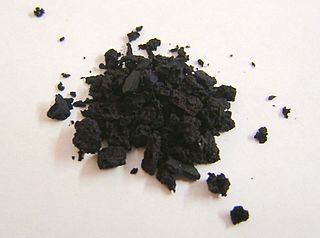
Titration is a common laboratory method of quantitative chemical analysis to determine the concentration of an identified analyte. A reagent, termed the titrant or titrator, is prepared as a standard solution of known concentration and volume. The titrant reacts with a solution of analyte to determine the analyte's concentration. The volume of titrant that reacted with the analyte is termed the titration volume.
A pH indicator is a halochromic chemical compound added in small amounts to a solution so the pH (acidity or basicity) of the solution can be determined visually or spectroscopically by changes in absorption and/or emission properties. Hence, a pH indicator is a chemical detector for hydronium ions (H3O+) or hydrogen ions (H+) in the Arrhenius model.

In chemistry, there are three definitions in common use of the word "base": Arrhenius bases, Brønsted bases, and Lewis bases. All definitions agree that bases are substances that react with acids, as originally proposed by G.-F. Rouelle in the mid-18th century.

Bromothymol blue is a pH indicator. It is mostly used in applications that require measuring substances that would have a relatively neutral pH. A common use is for measuring the presence of carbonic acid in a liquid. It is typically sold in solid form as the sodium salt of the acid indicator.

An acid–base titration is a method of quantitative analysis for determining the concentration of Brønsted-Lowry acid or base (titrate) by neutralizing it using a solution of known concentration (titrant). A pH indicator is used to monitor the progress of the acid–base reaction and a titration curve can be constructed.

Bromophenol blue, albutest is used as a pH indicator, an electrophoretic color marker, and a dye. It can be prepared by slowly adding excess bromine to a hot solution of phenolsulfonphthalein in glacial acetic acid.

Cerium(IV) sulfate, also called ceric sulfate, is an inorganic compound. It exists as the anhydrous salt Ce(SO4)2 as well as a few hydrated forms: Ce(SO4)2(H2O)x, with x equal to 4, 8, or 12. These salts are yellow to yellow/orange solids that are moderately soluble in water and dilute acids. Its neutral solutions slowly decompose, depositing the light yellow oxide CeO2. Solutions of ceric sulfate have a strong yellow color. The tetrahydrate loses water when heated to 180-200 °C.

Azo compounds are organic compounds bearing the functional group diazenyl.

Methyl orange is a pH indicator frequently used in titration because of its clear and distinct color variance at different pH values. Methyl orange shows red color in acidic medium and yellow color in basic medium. Because it changes color at the pKa of a mid strength acid, it is usually used in titration of strong acids in weak bases that reach the equivalence point at a pH of 3.1-4.4. Unlike a universal indicator, methyl orange does not have a full spectrum of color change, but it has a sharp end point. In a solution becoming less acidic, methyl orange changes from red to orange and, finally, to yellow—with the reverse process occurring in a solution of increasing acidity.

A universal indicator is a pH indicator made of a solution of several compounds that exhibit various smooth colour changes over a wide range pH values to indicate the acidity or alkalinity of solutions. A universal indicator can be in paper form or present in a form of a solution.

Phenol red is a pH indicator frequently used in cell biology laboratories.

The red cabbage is a kind of cabbage, also known as Blaukraut after preparation. Its leaves are coloured dark red/purple. However, the plant changes its colour according to the pH value of the soil due to a pigment belonging to anthocyanins. In acidic soils, the leaves grow more reddish; in neutral soils, they will grow more purple, while an alkaline soil will produce rather greenish-yellow coloured cabbages. This explains the fact that the same plant is known by different colours in various regions. It can be found in all of Europe, throughout the Americas, in China, and especially in Africa.

Methyl red (2-(N,N-dimethyl-4-aminophenyl) azobenzenecarboxylic acid), also called C.I. Acid Red 2, is an indicator dye that turns red in acidic solutions. It is an azo dye, and is a dark red crystalline powder. Methyl red is a pH indicator; it is red in pH under 4.4, yellow in pH over 6.2, and orange in between, with a pKa of 5.1. Murexide and methyl red are investigated as promising enhancers of sonochemical destruction of chlorinated hydrocarbon pollutants. Methyl red is classed by the IARC in group 3 - unclassified as to carcinogenic potential in humans.

Murexide (NH4C8H4N5O6, or C8H5N5O6·NH3), also called ammonium purpurate or MX, is the ammonium salt of purpuric acid. It is a purple solid that is soluble in water. The compound was once used as an indicator reagent. Aqueous solutions are yellow at low pH, reddish-purple in weakly acidic solutions, and blue-purple in alkaline solutions.

Litmus is a water-soluble mixture of different dyes extracted from lichens. It is often absorbed onto filter paper to produce one of the oldest forms of pH indicator, used to test materials for acidity. In an acidic medium, blue litmus paper turns red, while in a basic or alkaline medium, red litmus paper turns blue.

Bromocresol green (BCG) is a dye of the triphenylmethane family. It belongs to a class of dyes called sulfonephthaleins. It is used as a pH indicator in applications such as growth mediums for microorganisms and titrations. In clinical practise, it is commonly used as a diagnostic technique. The most common use of bromocresol green is to measure serum albumin concentration within mammalian blood samples in possible cases of kidney failure and liver disease. In chemistry, bromocresol green is used in Thin-layer chromatography staining solutions to visualize acidic compounds.

4-Nitrophenol is a phenolic compound that has a nitro group at the opposite position of the hydroxyl group on the benzene ring.

Acid orange 5 is a compound with formula Na(C6H5NHC6H4N=NC6H4SO3). It is an azo dye. It is also used as a pH indicator; it is red in pH under 1.4, orange-yellow in pH over 3.2.

A urine test strip or dipstick is a basic diagnostic tool used to determine pathological changes in a patient's urine in standard urinalysis.

Azo violet (Magneson I; p-nitrobenzeneazoresorcinol) is an azo compound with the chemical formula C12H9N3O4. It is used commercially as a violet dye and experimentally as a pH indicator, appearing yellow below pH 11, and violet above pH 13. It also turns deep blue in the presence of magnesium salt in a slightly alkaline, or basic, environment. Azo violet may also be used to test for the presence of ammonium ions. The color of ammonium chloride or ammonium hydroxide solution will vary depending upon the concentration of azo violet used. Magneson I is used to test Be also; it produces an orange-red lake with Be(II) in alkaline medium.




















